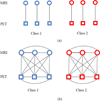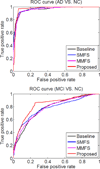Label-aligned multi-task feature learning for multimodal classification of Alzheimer's disease and mild cognitive impairment
- PMID: 26572145
- PMCID: PMC4868803
- DOI: 10.1007/s11682-015-9480-7
Label-aligned multi-task feature learning for multimodal classification of Alzheimer's disease and mild cognitive impairment
Abstract
Multimodal classification methods using different modalities of imaging and non-imaging data have recently shown great advantages over traditional single-modality-based ones for diagnosis and prognosis of Alzheimer's disease (AD), as well as its prodromal stage, i.e., mild cognitive impairment (MCI). However, to the best of our knowledge, most existing methods focus on mining the relationship across multiple modalities of the same subjects, while ignoring the potentially useful relationship across different subjects. Accordingly, in this paper, we propose a novel learning method for multimodal classification of AD/MCI, by fully exploring the relationships across both modalities and subjects. Specifically, our proposed method includes two subsequent components, i.e., label-aligned multi-task feature selection and multimodal classification. In the first step, the feature selection learning from multiple modalities are treated as different learning tasks and a group sparsity regularizer is imposed to jointly select a subset of relevant features. Furthermore, to utilize the discriminative information among labeled subjects, a new label-aligned regularization term is added into the objective function of standard multi-task feature selection, where label-alignment means that all multi-modality subjects with the same class labels should be closer in the new feature-reduced space. In the second step, a multi-kernel support vector machine (SVM) is adopted to fuse the selected features from multi-modality data for final classification. To validate our method, we perform experiments on the Alzheimer's Disease Neuroimaging Initiative (ADNI) database using baseline MRI and FDG-PET imaging data. The experimental results demonstrate that our proposed method achieves better classification performance compared with several state-of-the-art methods for multimodal classification of AD/MCI.
Keywords: Alzheimer’s disease; Feature selection; Label alignment; Mild cognitive impairment; Multi-task learning; Multimodal classification.
Conflict of interest statement
All authors declare that they have no conflict of interest.
Figures







Similar articles
-
A review on neuroimaging-based classification studies and associated feature extraction methods for Alzheimer's disease and its prodromal stages.Neuroimage. 2017 Jul 15;155:530-548. doi: 10.1016/j.neuroimage.2017.03.057. Epub 2017 Apr 13. Neuroimage. 2017. PMID: 28414186 Free PMC article. Review.
-
Discriminative multi-task feature selection for multi-modality classification of Alzheimer's disease.Brain Imaging Behav. 2016 Sep;10(3):739-49. doi: 10.1007/s11682-015-9437-x. Brain Imaging Behav. 2016. PMID: 26311394 Free PMC article.
-
Hypergraph based multi-task feature selection for multimodal classification of Alzheimer's disease.Comput Med Imaging Graph. 2020 Mar;80:101663. doi: 10.1016/j.compmedimag.2019.101663. Epub 2019 Dec 19. Comput Med Imaging Graph. 2020. PMID: 31923610
-
Manifold regularized multitask feature learning for multimodality disease classification.Hum Brain Mapp. 2015 Feb;36(2):489-507. doi: 10.1002/hbm.22642. Epub 2014 Oct 3. Hum Brain Mapp. 2015. PMID: 25277605 Free PMC article.
-
MRI Radiomics Classification and Prediction in Alzheimer's Disease and Mild Cognitive Impairment: A Review.Curr Alzheimer Res. 2020;17(3):297-309. doi: 10.2174/1567205017666200303105016. Curr Alzheimer Res. 2020. PMID: 32124697 Review.
Cited by
-
Diagnosis of Alzheimer's Disease Severity with fMRI Images Using Robust Multitask Feature Extraction Method and Convolutional Neural Network (CNN).Comput Math Methods Med. 2021 Apr 27;2021:5514839. doi: 10.1155/2021/5514839. eCollection 2021. Comput Math Methods Med. 2021. PMID: 34007305 Free PMC article.
-
Multi-modal neuroimaging feature selection with consistent metric constraint for diagnosis of Alzheimer's disease.Med Image Anal. 2020 Feb;60:101625. doi: 10.1016/j.media.2019.101625. Epub 2019 Dec 2. Med Image Anal. 2020. PMID: 31841947 Free PMC article.
-
Classification of Alzheimer's Disease, Mild Cognitive Impairment, and Cognitively Unimpaired Individuals Using Multi-feature Kernel Discriminant Dictionary Learning.Front Comput Neurosci. 2018 Jan 9;11:117. doi: 10.3389/fncom.2017.00117. eCollection 2017. Front Comput Neurosci. 2018. PMID: 29375356 Free PMC article.
-
Multimodal Integration of Brain Images for MRI-Based Diagnosis in Schizophrenia.Front Neurosci. 2019 Nov 7;13:1203. doi: 10.3389/fnins.2019.01203. eCollection 2019. Front Neurosci. 2019. PMID: 31787874 Free PMC article.
-
A review on neuroimaging-based classification studies and associated feature extraction methods for Alzheimer's disease and its prodromal stages.Neuroimage. 2017 Jul 15;155:530-548. doi: 10.1016/j.neuroimage.2017.03.057. Epub 2017 Apr 13. Neuroimage. 2017. PMID: 28414186 Free PMC article. Review.
References
-
- Al NFE. Principal component analysis of FDG PET in amnestic MCI. European Journal of Nuclear Medicine & Molecular Imaging. 2008;35(12):2191–2202. (2112). - PubMed
-
- Bouwman FH, Flier WM, Van Der Schoonenboom NSM, Elk EJ, Van Kok A, Rijmen F. Longitudinal changes of CSF biomarkers in memory clinic patients. Neurology. 2007;69(10):1006–1011. - PubMed
-
- Brookmeyer R, Johnson E, Ziegler-Grahamm K, Arrighi HM, Brookmeyer R, Johnson E. O1-02-01 Forecasting the Global Burden of Alzheimer's Disease. Alzheimers & Dementia the Journal of the Alzheimers Association. 2007;3(3):186–191. - PubMed
-
- Chang CC, Lin CJ. LIBSVM: a library for support vector machines. Acm Transactions on Intelligent Systems & Technology. 2007;2(3):389–396.
Publication types
MeSH terms
Substances
Grants and funding
LinkOut - more resources
Full Text Sources
Other Literature Sources
Medical

